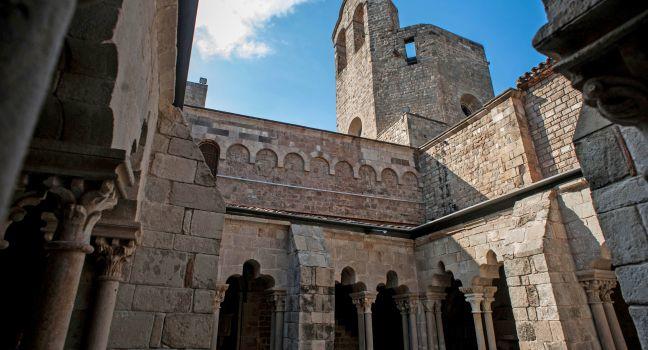Antic Hospital de la Santa Creu

Founded in the 10th century, one of Europe's earliest medical complexes contains some of Barcelona's most impressive Gothic architecture. The buildings that survive today date from mainly to the 15th and 16th centuries; the first stone for the hospital was laid by King Martí el Humà (Martin the Humane) in 1401.
From the entrance on Carrer del Carme, the first building on the left is the 18th-century Reial Acadèmia de Medicina de Catalunya (Royal Academy of Medicine); the surgical amphitheater is kept just as it was in the days when students learned by observing dissections. (One assumes that the paupers' hospital next door was always ready to oblige with cadavers.) The Academy is open to the public for guided tours on Wednesday and Saturday mornings.
Across the way on the right is the gateway into the patio of the Casa de la Convalescència, where patients who survived their treatment in the hospital were moved for recuperation. It now houses the Institute for Catalan Studies. The walls of the forecourt are covered with brightly decorated scenes of the life of St. Paul in blue and yellow ceramic tiles. The story begins with the image to the left of the door to the inner courtyard, recounting the moment of the saint's conversion: Savle, Savle, quid me persegueris? ("Saul, Saul, why do you persecute me?").
The ceramicist, Llorenç Passolas, also designed the late-17th-century tiles around the inner patio. The image of St. Paul in the center of the pillared courtyard, over what was once a well, pays homage to the building's first benefactor, Pau Ferran. Look for the horseshoes, two of them around the keyholes, on the double wooden doors in the entryway: tokens of good luck for the afflicted who came here to recover—again, in reference to benefactor Ferran, from ferro (iron), as in ferradura (horseshoe).
Through a gate to the left of the Casa de Convalescència is the garden-courtyard of the hospital complex, the Jardins de Rubió i Lluc, centered on a baroque cross and lined with orange trees. On the right is the Biblioteca de Catalunya ( Carrer de l'Hospital 56 93/270–2300 www.bnc.cat Closed Sun.), Catalonia's national library and—with some 2 million volumes in its collection—second only to Madrid's Biblioteca Nacional. The stairway under the arch, leading up to the library, was built in the 16th century. The Gothic well to the left of the arch is from the 15th century, as is the little Romeo-and-Juliet balcony in the corner to the left of the doors to the Escola Massana academy of design. The library itself is spectacular: two parallel halls—once the core of the hospital—230 feet long, with towering Gothic arches and vaulted ceilings, designed in the 15th century by the architect of the church of Santa Maria del Pi, Guillem Abiell. This was the hospital where Antoni Gaudí was taken, unrecognized and assumed to be a pauper, after he was struck by a trolley on June 7, 1926.
Among the library's collections are archives recording Gaudí's admittance and photographs of the infirmary and the private room where he died. The staggering antiquarian resources here go back to the earliest history of printing, and range from silver medieval book covers to illuminated manuscripts from the Llibre Vermell (Red Book) of medieval Catalonian liturgical music, to rare editions of Cervantes.
Leave the complex through the heavy wooden doors to Carrer Hospital, and turn left toward La Rambla. The next set of doors leads to the Capella (Chapel) of the hospital, an interesting art space well worth a visit. Built in the early 15th century, on the site of what had been the old Hospital de Colom (founded in 1219), it is now a showcase for promising young artists, chosen by a jury of prominent museum directors and given this impressive space, with its Romanesque tunnel vault and medieval arches, to exhibit their work.





